coolant temperature CHEVROLET CAVALIER 1994 1.G Owners Manual
[x] Cancel search | Manufacturer: CHEVROLET, Model Year: 1994, Model line: CAVALIER, Model: CHEVROLET CAVALIER 1994 1.GPages: 243, PDF Size: 15.06 MB
Page 11 of 243
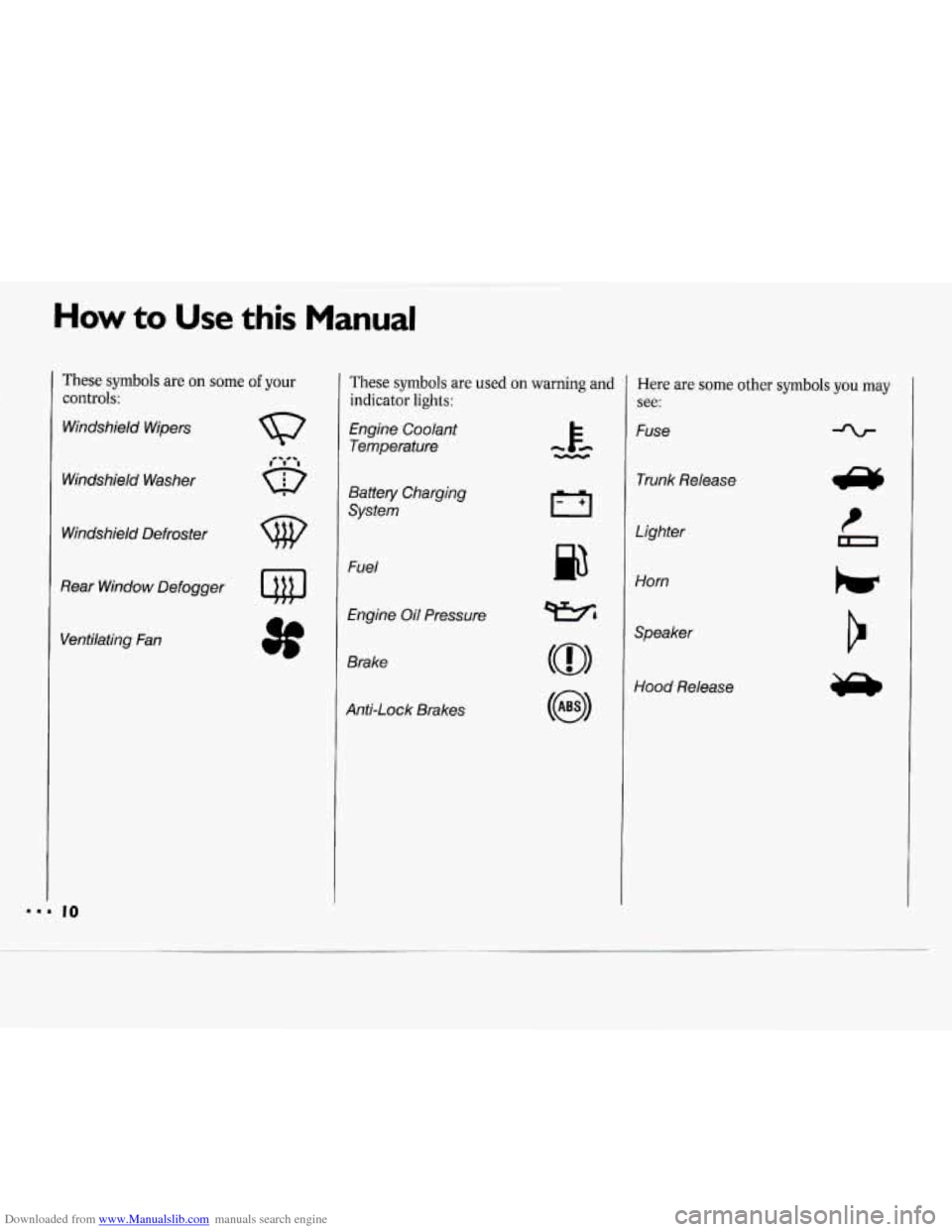
Downloaded from www.Manualslib.com manuals search engine How to Use this Manual
These symbols are on some of your
controls:
Windshield Wipers
Windshield Washer
Windshield Defroster
Rear Window Defogger
Ventilating Fan
These symbols are used on warning and
indicator
lights:
Engine Coolant
Temperature
Battery Charging
System
Fuel
Engine Oil Pressure
Brake
Anti-Lock Brakes
p3
Here are some other symbols you may
see:
Fuse
Trunk Release
Lighter
Horn
Speaker
Hood Release
Page 86 of 243
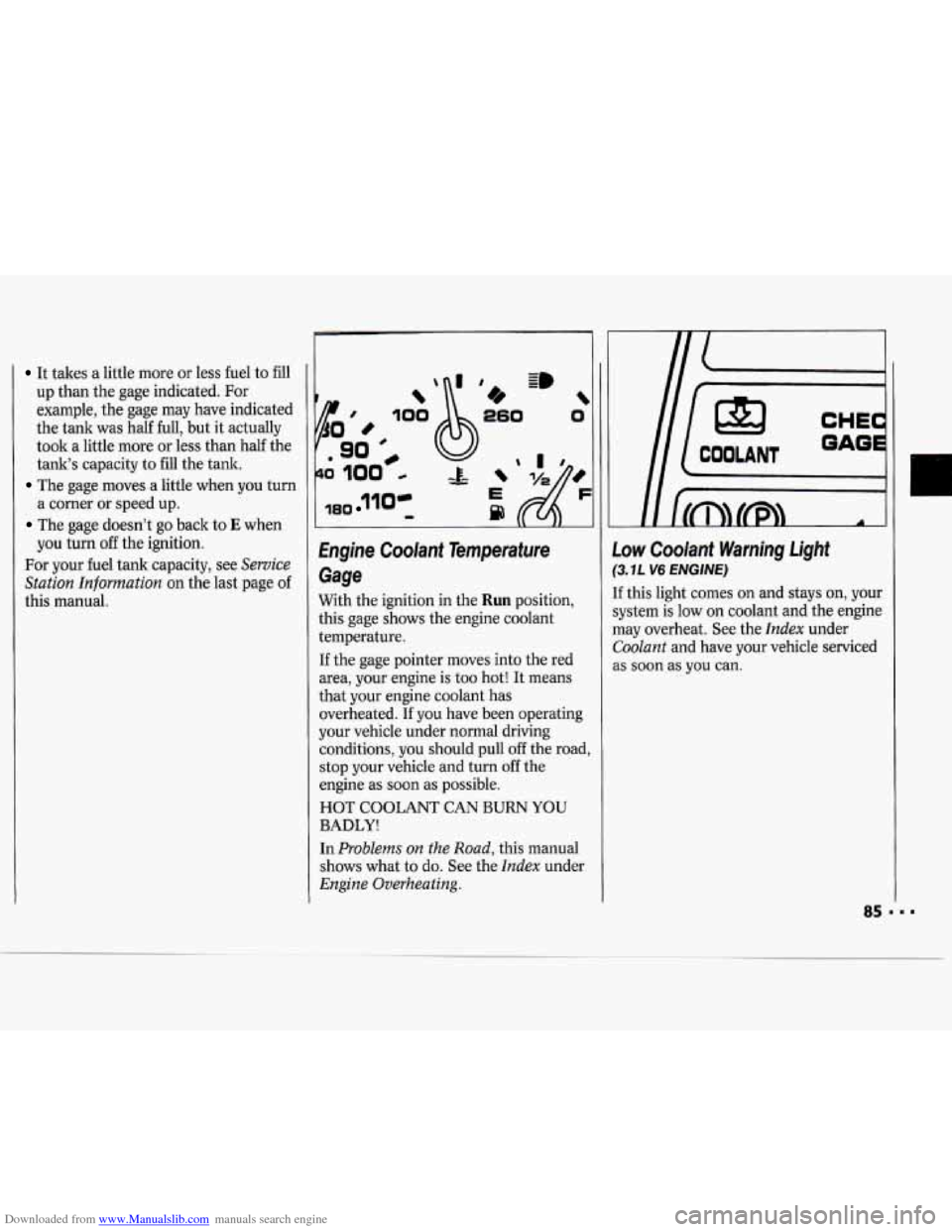
Downloaded from www.Manualslib.com manuals search engine It takes a little more or less fuel to fill
up than the gage indicated. For
example, the gage may have indicated
the tank was half full, but it actually
took
a little more or less than half the
tank’s capacity to fill the tank.
The gage moves a little when you turn
a corner or speed up.
The gage doesn’t go back to E when
you turn off the ignition.
For your fuel tank capacity, see
Service
Station Information
on the last page of
this manual.
I80 110- -
hgine Coolant Temperature
Gage
With the ignition in the Run position,
this gage shows the engine coolant
temperature.
If the gage pointer moves into the red
area, your engine is too hot! It means
that
your engine coolant has
overheated.
If you have been operating
your vehicle under normal driving
conditions, you should pull
off the road,
stop your vehicle and turn
off the
engine as soon as possible.
HOT COOLANT CAN
BURN YOU
BADLY!
In Problems on the Road, this manual
shows what
to do. See the Index under
Engine Overheating.
Low Coolant Warning Light
(3.1 L V6 ENGINE)
If this light comes on and stays on, your
system is low on coolant and the engine
may overheat. See the
Index under
Coolant and have your vehicle serviced
as soon
as you can.
1
Page 93 of 243
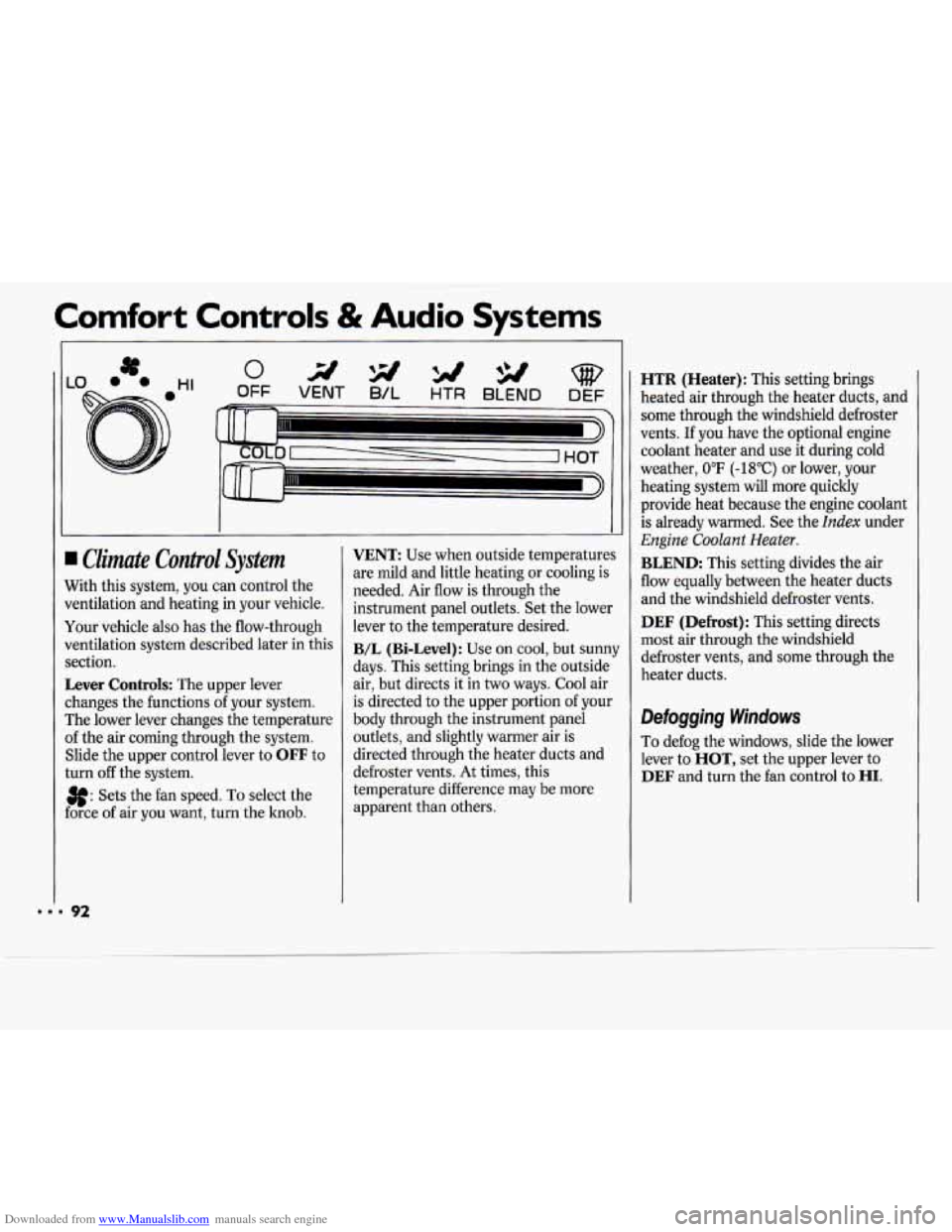
Downloaded from www.Manualslib.com manuals search engine Comfort Controls & Audio Systems
I Climate Control System
Nith this system, you can control the
rentilation and heating in your vehicle.
four vehicle also has the flow-through
Jentilation system described later in this
rection.
Lever Controls: The upper lever
:hanges the functions
of your system.
rhe lower lever changes the temperature
If the air coming through the system.
Slide the upper control lever to
OFF to
:urn
off the system.
3f: Sets the fan speed. To select the
:orce of air you want, turn the knob.
VENT: Use when outside temperatures
are mild and little heating or cooling is
needed. Air flow is through the
instrument panel outlets. Set the lower
lever to the temperature desired.
B/L (Bi-Level): Use on cool, but sunny
days. This setting brings in the outside
air, but directs it in two ways. Cool air
is directed to the upper portion of your
body through the instrument panel
outlets, and slightly warmer air is
directed through the heater ducts and
defroster vents.
At times, this
temperature difference may be more
apparent than others.
HTR (Heater): This setting brings
heated air through the heater ducts, and
some through the windshield defroster
vents.
If you have the optional engine
coolant heater and use it during cold
weather,
0°F (-18°C) or lower, your
heating system will more quickly
provide heat because the engine coolant
is already warmed. See the
Index under
Engine Coolant Heater.
BLEND: This setting divides the air
flow equally between the heater duets
and the windshield defroster vents.
DEF (Defrost): This setting directs
most air through the windshield
defroster vents, and some through the
heater ducts.
Defogging Windows
To defog the windows, slide the lower
lever to
HOT, set the upper lever to
DEF and turn the fan control to HI.
Page 137 of 243
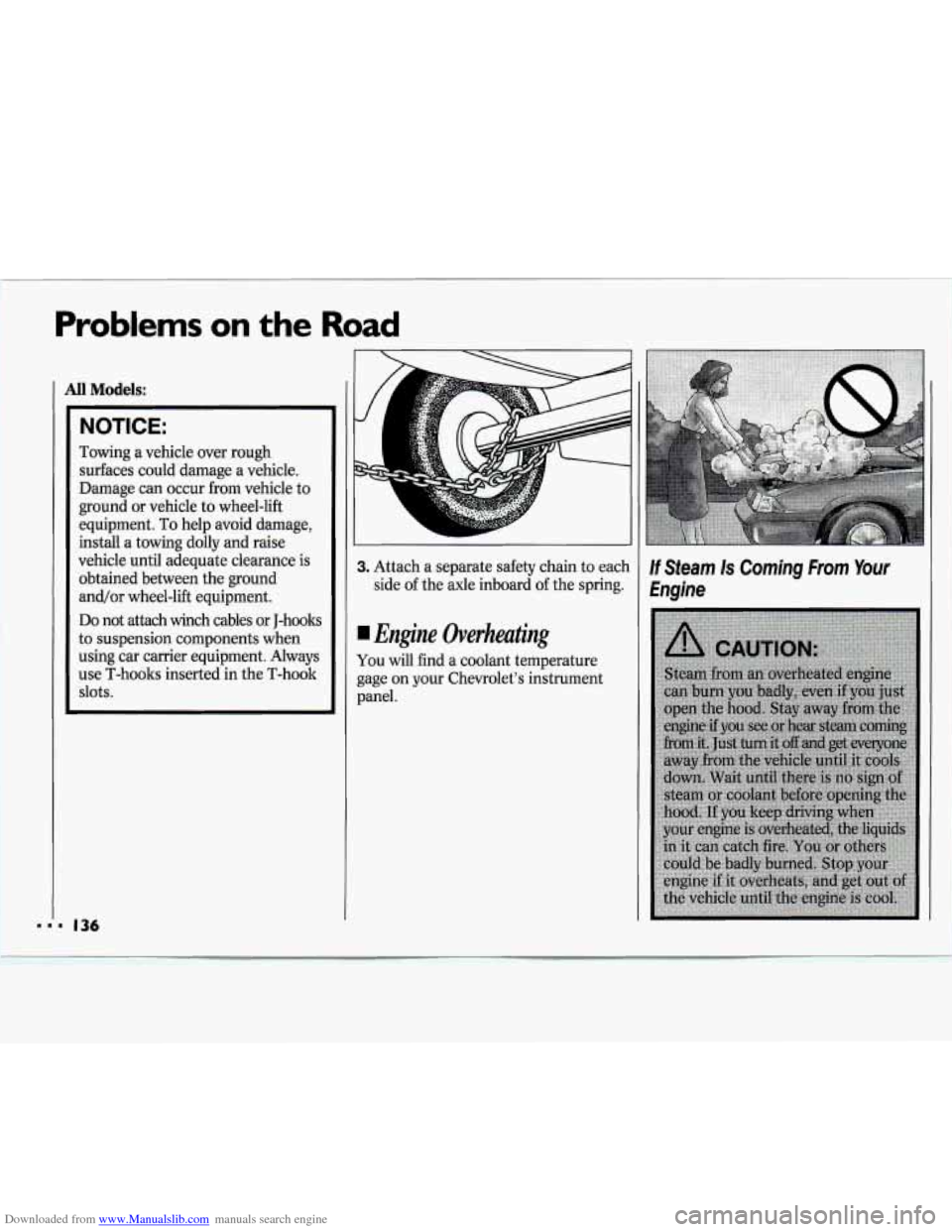
Downloaded from www.Manualslib.com manuals search engine Problems on the Road
All Models:
NOTICE:
Towing a vehicle over rough
surfaces could damage a vehicle.
Damage can occur from vehicle to
ground or vehicle to wheel-lift
equipment. To help avoid damage,
install a towing dolly and raise
vehicle until adequate clearance is
obtained between the ground
and/or wheel-lift equipment.
Do not attach winch cables or J-hooks
to suspension components when
using car carrier equipment. Always
use T-hooks inserted in the T-hook
slots.
r I I
3. Attach a separate safety chain to each
side of the axle inboard
of the spring.
Engine Overheating
You will find a coolant temperature
gage on your Chevrolet’s instrument
panel.
If Steam Is Coming From Your
Engine
Page 171 of 243
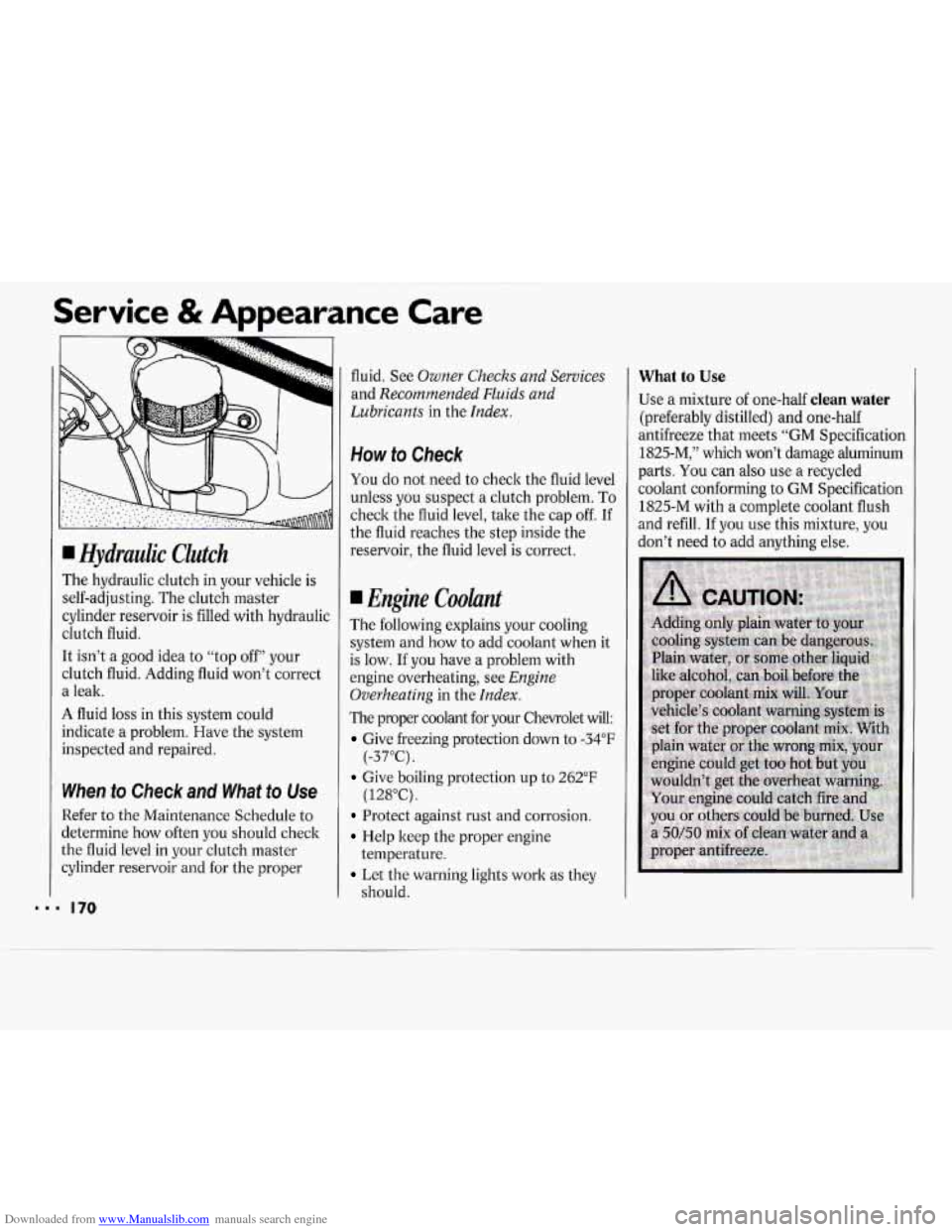
Downloaded from www.Manualslib.com manuals search engine ~~ ~ Service & Appearance Care
170
I Hydraulic Clutch
The hydraulic clutch
in your vehicle is
self-adjusting. The clutch master
cylinder reservoir is filled with hydraulic
clutch fluid.
It isn’t
a good idea to “top off” your
clutch fluid. Adding fluid won’t correct
a leak.
A fluid loss in this system could
indicate a problem. Have the system
inspected and repaired.
When to Check and What to Use
Refer to the Maintenance Schedule to
determine how often
you should check
the fluid level in your clutch master
cylinder reservoir and for the proper fluid. See
Owner Checks and
Services
and Recommended Fluids and
Lubricants
in the Index.
How to Check
You do not need to check the fluid level
unless you suspect a clutch problem.
To
check the fluid level, take the cap off. If
the fluid reaches the step inside the
reservoir, the fluid level is correct.
I Engine Coolunt
The following explains your cooling
system and how
to add coolant when it
is low.
If you have a problem with
engine overheating, see
Engine
Overheating
in the Index.
The proper coolant for your Chevrolet will:
Give freezing protection down to -34°F
Give boiling protection up to 262°F
Protect against rust and corrosion.
Help keep the proper engine
Let the warning lights work as they
(-37°C).
(128°C).
temperature.
should.
What to Use
Use a mixture
of one-half clean water
(preferably distilled) and one-half
antifreeze that meets “GM Specification
1825-M,” which won’t damage aluminum
parts. You can also use a recycled
coolant conforming to GM Specification
1825-M with
a complete coolant flush
and refill. If you use this mixture, you
don’t need to add anything else.
Page 173 of 243
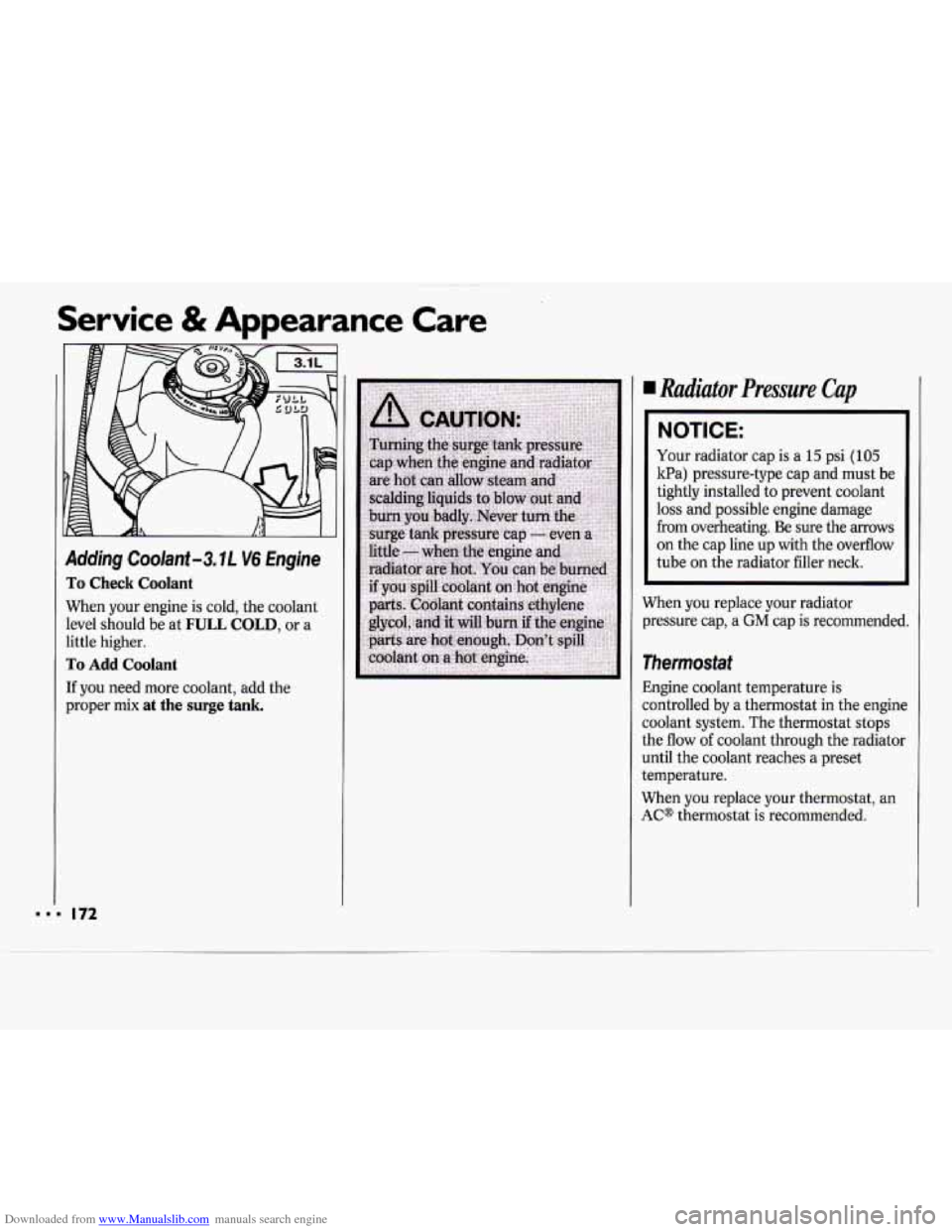
Downloaded from www.Manualslib.com manuals search engine Dl
~ ~~ ~~ ~
Service & Appearance Care
ID
Adding Coolant -3. IL V6 Engine
To Check Coolant
When your engine is cold, the coolant
level should be at
FULL COLD, or a
little
higher.
To Add Coolant
If you need more coolant, add the
proper
mix at the surge tank.
I72
Radiator Pressure Cap
NOTICE:
Your radiator cap is a 15 psi (105
kPa) pressure-type cap and must be
tightly installed to prevent coolant
loss and possible engine damage
from overheating. Be sure the arrows
on the cap line up with the overflow
tube on the radiator filler neck.
When
you replace your radiator
pressure cap, a
GM cap is recommended.
Thermostat
Engine coolant temperature is
controlled by a thermostat in the engine
coolant system. The thermostat stops
the flow of coolant through the radiator
until the coolant reaches a preset
temperature.
When
you replace your thermostat, an
AC@ thermostat is recommended.
Page 211 of 243
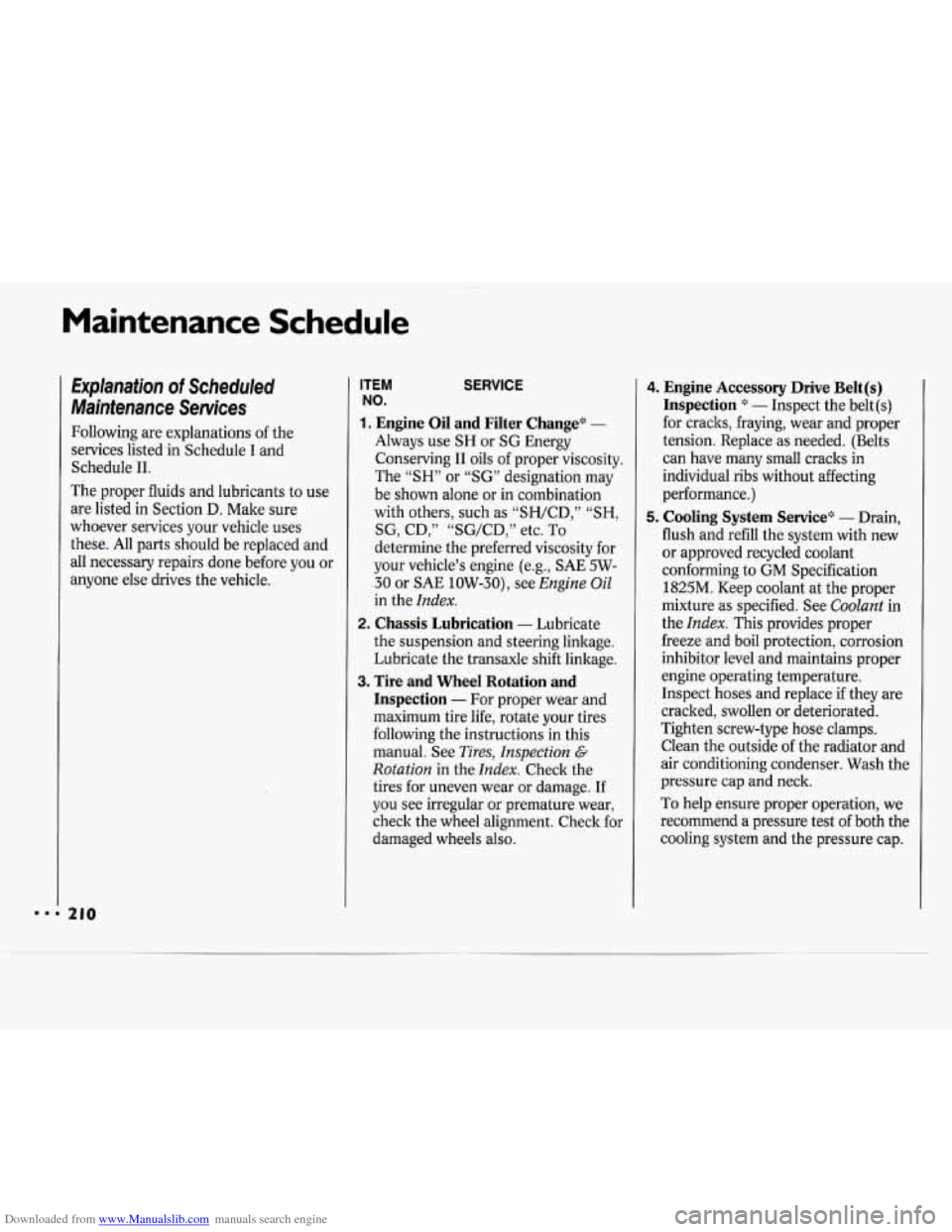
Downloaded from www.Manualslib.com manuals search engine Maintenance Schedule
Explanation of Scheduled
Maintenance Services
Following are explanations of the
services listed in Schedule
I and
Schedule 11.
The proper fluids and lubricants to use
are listed in Section
D. Make sure
whoever services your vehicle uses
these. All parts should be replaced and
all necessary repairs done before you or
anyone else drives the vehicle.
ITEM SERVICE
NO.
1. Engine Oil and Filter Change* -
Always use SH or SG Energy
Conserving I1 oils of proper viscosity.
The
“SH” or “SG” designation may
be shown alone or in combination
with others, such as “SH/CD,”
“SH,
SG, CD,” “SG/CD,” etc. To
determine the preferred viscosity for
your vehicle’s engine (e.g., SAE 5W-
30 or SAE 10W-30), see
Engine Oil
in the Index.
the suspension and steering linkage.
Lubricate the transaxle shift linkage.
Inspection - For proper wear and
maximum tire life, rotate your tires
following the instructions in this
manual. See
Tires, Inspection G
Rotation in the Index. Check the
tires for uneven wear or damage. If
you see irregular or premature wear,
check the wheel alignment. Check for
damaged wheels also.
2. Chassis Lubrication - Lubricate
3. Tire and Wheel Rotation and
4. Engine Accessory Drive Belt(s)
Inspection
* - Inspect the belt (s)
for cracks, fraying, wear and proper
tension. Replace as needed. (Belts
can have many small cracks in
individual ribs without affecting
performance.)
5. Cooling System Service* - Drain,
flush and refill the system with new
or approved recycled coolant
conforming to
GM Specification
1825M. Keep coolant at the proper
mixture as specified. See
Coolant in
the
Index. This provides proper
freeze and boil protection, corrosion
inhibitor level and maintains proper
engine operating temperature.
Inspect hoses and replace if they are
cracked, swollen or deteriorated.
Tighten screw-type hose clamps.
Clean the outside of the radiator and
air conditioning condenser. Wash the
pressure cap and neck.
To help ensure proper operation, we
recommend a pressure test
of both the
cooling system and the pressure cap.
Page 235 of 243
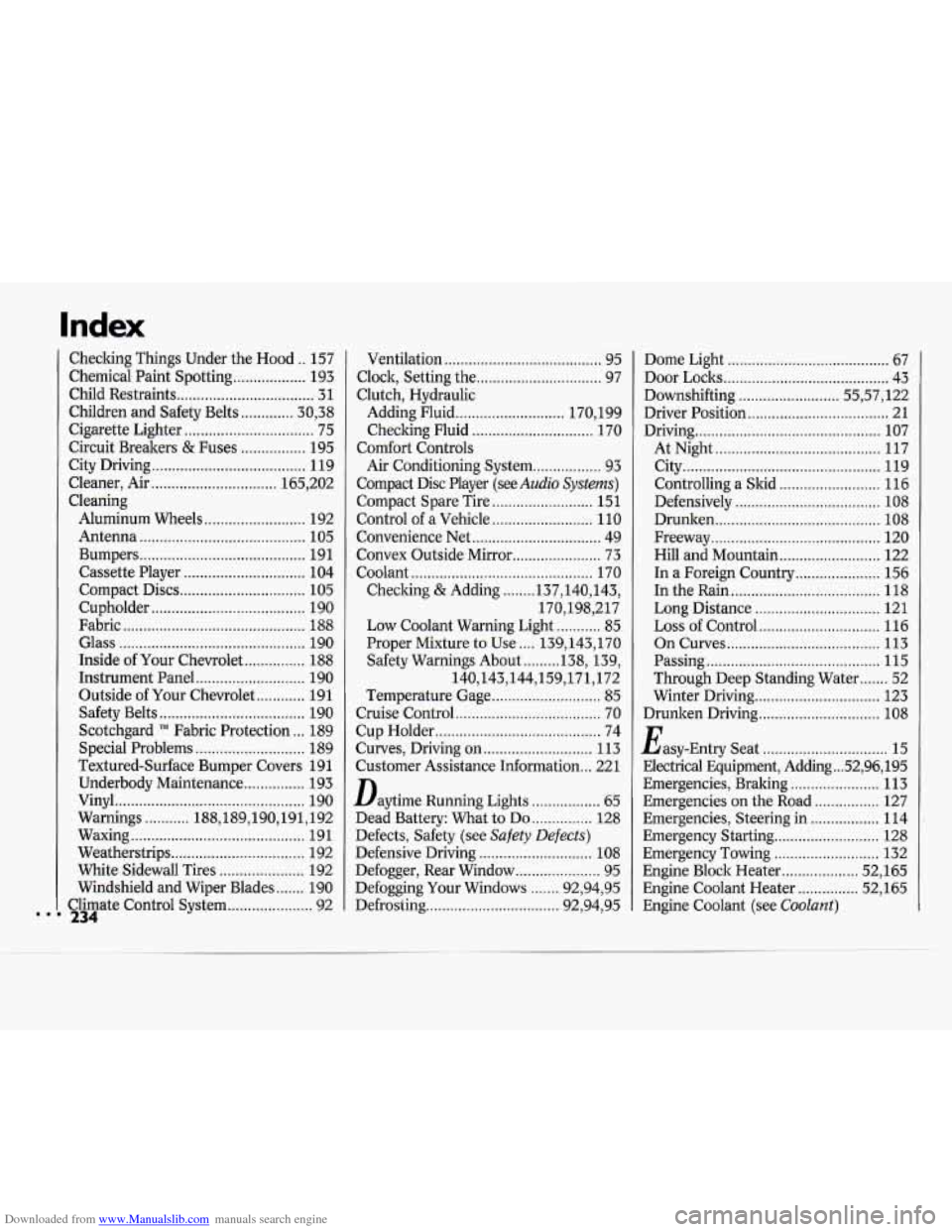
Downloaded from www.Manualslib.com manuals search engine Checking Things Under the Hood .. 157
Child Restraints
.................................. 31
Children and Safety Belts ............. 30. 38
Cigarette Lighter
................................ 75
Circuit Breakers
& Fuses ................ 195
City Driving.,
.................................... 119
Cleaner. Air ............................... 165. 202
Cleaning Chemical
Paint Spotting
.................. 193
Aluminum Wheels
......................... 192
Antenna
......................................... 105
Bumpers
......................................... 191
Cassette Player .............................. 104
Compact Discs
............................... 105
Cupholder
...................................... 190
Fabric
............................................. 188
Glass .............................................. 190
Inside of Your Chevrolet
............... 188
Instrument Panel ........................... 190
Outside of Your Chevrolet
............ 191
Safety Belts
.................................... 190
Scotchgard
TM Fabric Protection ... 189
Textured-Surface Bumper Covers 191
Underbody Maintenance
............... 193
Vinyl
............................................... 190
Warnings
........... 188,189,190,191, 192
Waxing
........................................... 191
Weatherstrips
................................. 192
White Sidewall Tires
..................... 192
Windshield and Wiper Blades
....... 190
Climate Control System
..................... 92
Special Problems
........................... 189
234
Ventilation ....................................... 95
Clock. Setting the
............................... 97
Clutch, Hydraulic Adding Fluid
........................... 170, 199
Checking Fluid
.............................. 170
Comfort Controls
Compact Disc Player (see
Audio Systems)
Compact Spare Tire ......................... 151
Control of
a Vehicle ......................... 110
Convenience Net
................................ 49
Convex Outside Mirror
...................... 73
Coolant
............................................. 170
Checking
& Adding ........ 137,140,143,
170,198, 217
Low Coolant Warning Light ........... 85
Proper Mixture to Use .... 139,143, 170
140,143,144,159,171, 172
Temperature Gage
........................... 85
Cruise Control .................................... 70
Cup Holder
......................................... 74
Customer Assistance Information
... 22 1
Daytime Running Lights ................. 65
Dead Battery: What to Do ............... 128
Defects, Safety (see
Safety Defects)
Defensive Driving ............................ 108
Air Conditioning System
................. 93
Safety Warnings About
......... 138, 139,
Curves, Driving on
........................... 113
Defogger, Rear Window ..................... 95
Defogging Your Windows
...... .92,94, 95
Defrosting
................................. 92,94, 95 Dome Light
........................................ 67
Door Locks
......................................... 43
Downshifting
......................... 55.57. 122
Driver Position
................................... 21
Drnmg 107
At Night
......................................... 117
City
................................................. 119
Controlling a Slid
......................... 116
Defensively
.................................... 108
Drunken
......................................... 108
Freeway
.......................................... 120
Hill and Mountain
......................... 122
In a Foreign Country
..................... 156
In the Rain
..................................... 118
Long Distance ............................... 121
Loss of Control
.............................. 116
On Curves ...................................... 113
Passing ........................................... 115
Through Deep Standing Water ....... 52
Winter Driving
............................... 123
.. ..............................................
..............................
E
Drunken Driving 108
asy-Entry Seat
............................... 15
Electrical Equipment, Adding ... 52,96, 195
Emergencies, Braking
...................... 113
Emergencies on the Road ................ 127
Emergencies, Steering in
................. 114
Emergency Starting
.......................... 128
Emergency Towing
.......................... 132
Engine Block Heater
................... 52, 165
Engine Coolant Heater
............... 52, 165
Engine Coolant (see
Coolant)
Page 236 of 243
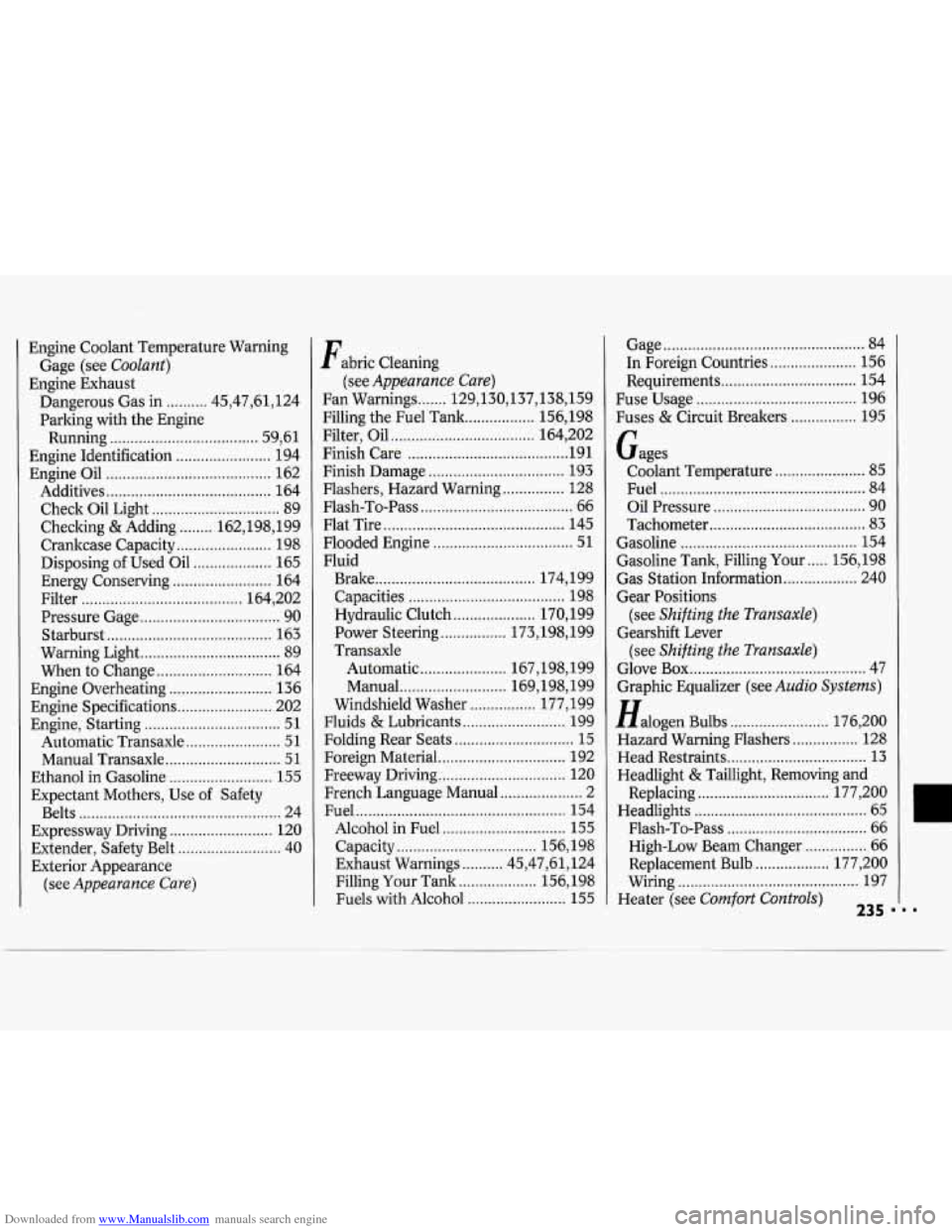
Downloaded from www.Manualslib.com manuals search engine Engine Coolant Temperature Warning
Engine Exhaust Gage (see
Coolant)
Dangerous Gas
in .......... 45.47.61. 124
Parking with the Engine
Running
.................................... 59. 61
Engine Identification
....................... 194
Engine Oil
........................................ 162
Additives
........................................ 164
Check Oil Light
............................... 89
Checking &Adding
........ 162.198. 199
Crankcase Capacity
....................... 198
Disposing of Used Oil
................... 165
Energy Conserving
........................ 164
Filter
....................................... 164. 202
Pressure Gage
.................................. 90
Starburst
........................................ 163
Warning Light
.................................. 89
When to Change
............................ 164
Engine Overheating
......................... 136
Engine Specifications ....................... 202
Engine. Starting
................................. 51
Automatic Transaxle
....................... 51
Manual Transaxle
............................ 51
Ethanol in Gasoline
......................... 155
Expectant Mothers. Use
of Safety
Belts
................................................. 24
Extender. Safety Belt
......................... 40
Exterior Appearance
Expressway Driving
......................... 120
(see Appearance
Care)
Fabric Cleaning
Fan Warnings
....... 129.130.137.138. 159
Filling the Fuel Tank
................. 156. 198
Filter. Oil
................................... 164, 202
Finish Care
....................................... 19 1
Finish Damage ................................. 193
Flashers, Hazard Warning
............... 128
Flash-To-Pass
..................................... 66
Flat Tire
............................................ 145
Flooded Engine
.................................. 51
Fluid Brake
....................................... 174, 199
Capacities
...................................... 198
Hydraulic Clutch
.................... 170. 199
Power Steering
................ 173,198, 199
Transaxle Automatic
..................... 167,198, 199
Manual
.......................... 169,198, 199
Windshield Washer
................ 177, 199
Fluids
& Lubricants ......................... 199
Foreign Material
............................... 192
Freeway Driving
............................... 120
French Language Manual
.................... 2
Fuel
................................................... 154
Alcohol in Fuel
.............................. 155
Capacity
.................................. 156, 198
Exhaust Warnings
.......... 45,47,61, 124
Filling Your Tank
................... 156, 198
Fuels with Alcohol
........................ 155
(see
Appearance
Care)
Folding Rear Seats ............................. 15
Gage ................................................. 84
In Foreign Countries ..................... 156
Requirements
................................. 154
Fuse Usage
....................................... 196
Fuses
& Circuit Breakers ................ 195
Gages Coolant Temperature
...................... 85
Fuel .................................................. 84
Oil Pressure
..................................... 90
Tachometer
...................................... 83
Gasoline ........................................... 154
Gasoline Tank, Filling Your
..... 156, 198
Gas Station Information
.................. 240
Gear Positions
Gearshift Lever
Glove Box
........................................... 47
Graphic Equalizer (see
Audio Systems)
Halogen Bulbs ........................ 176, 200
Head Restraints
.................................. 13
Headlight & Taillight, Removing and
(see
Shifting
the Transaxle)
(see Shifting the Transaxle)
Hazard Warning Flashers ................ 128
Replacing
................................ 177, 200
Headlights
.......................................... 65
Flash-To-Pass
.................................. 66
High-Low Beam Changer
............... 66
Replacement Bulb
.................. 177, 200
Wiring
............................................ 197
Heater (see
Comfort Controls) 235 1 . .